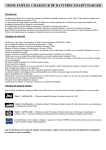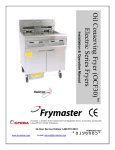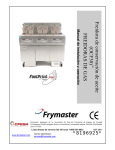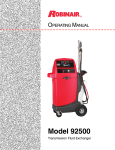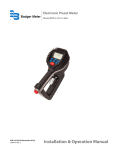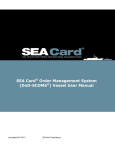Download Saitek SmartCharger Instruction manual
Transcript
QUICK START To try out your SmartCharger right away without reading the entire manual first, follow these simple steps to recharge a single battery. For more detailed information and instructions on how to charge up to four batteries at one time, see Section One. Warning: Read IMPORTANT SAFETY INFORMATION overleaf before you start! 1 Make sure there are no batteries installed in the compartment. 2 Plug the jack of the AC-DC adapter into the socket of the SmartCharger. Then plug the AC-DC adapter into a wall socket (see KEYS AND FEATURES). 3 Open the lid by pressing the button that is in front of the lid. 4 Pull back one of the metal contact plates and insert your 1.2V Ni-Cd or Ni-MH (AAA, AA, C or D size) battery into a slot, making sure that the battery is placed so that the "+" symbol on the battery is in the same position as the "+" symbol inside the compartment. If you wish to recharge a 1.2V prismatic battery instead, first insert the prismatic adapter into the slot (see section 1.2). Then insert the 1.2V prismatic battery. Again, make sure that the position of the"+" symbol on the battery matches with that of the"+" symbol inside the compartment. The SmartCharger INSTRUCTION MANUAL KEYS AND FEATURES INTRODUCTION Close the lid and watch the LCD as the SmartCharger evaluates your battery to test its recharging needs. Charging will then begin automatically. If the battery is not suitable for recharging, the Bad Battery symbol $ will appear on the LCD. Open the lid, remove the bad battery and then try another battery! If you are in a hurry to use the battery you are charging, you may remove and use it as soon as you see the TopOff/Trickle Charge icons on the LCD even though, during Top-Off Charge mode, the battery may only be 80%-90% recharged. Otherwise, you can wait until the battery is fully recharged by looking out for the Charged Battery symbol ^. Either way, your battery will be ready to use, with a new lease on life! To learn how to charge up to four batteries at one time, see Section One! SECTION ONE: BASIC OPERATING INSTRUCTIONS 1.1 Batteries Out, Power On 1.2 Inserting the Batteries 1.3 Charging Begins 1.4 Checking 1.2V Ni-Cd/Ni-MH Batteries 1.5 Revitalising 1.2V Ni-Cd/Ni-MH Batteries 1.6 9V Battery Charging 1.7 Bad Battery Symbol Appears? Here's Why! 1.8 Recharging is Complete! 1.9 Batteries Out, Power Down SECTION TWO: SPECIAL FEATURES ON RECHARGING 1.2V Ni-Cd/Ni-MH BATTERIES 2.1 Built-in Microprocessor 2.2 1.2V Ni-Cd/Ni-MH Battery Checking 2.3 High-tech, Super-fast Charging Capabilities on 1.2V Ni-Cd or Ni-MH Batteries Negative Pulse Soft-Start Intelligent Discharge System (IDS) Negative Delta V and Delta V Square over Delta t Square Technologies 2.4 Advanced Features on Charging 1.2V Ni-Cd/Ni-MH Batteries Super-fast Charging Capabilities User-friendly Operation Negative Delta V and Delta V Square over Delta t Square Memory Effect Suppressor Triple Overcharge Guard SECTION THREE: TECHNICAL DETAILS 3.1 Care and Maintenance 3.2 Technical Specifications TROUBLESHOOTING GUIDE IMPORTANT SAFETY INFORMATION READ BEFORE USE The following precautions must be observed when operating the SmartCharger. To reduce the risk of electric shock, fire or injury, pleas* read the points below before using the unit, and follow the rules during use. Failure to observe these safety rules will render the warranty void USING THE SMARTCHARGER • Place the SmartCharger on a dry, stable surface when in use. Do not position th< unit above a heater or a heating vent. Do not place the unit where it can fall into or come into contact with water. Do not place the unit on a vibrating surface such as a washing machine. • If the unit comes into contact with water or any other liquids, immediately unplug your SmartCharger. Do not remove the unit from the liquid until you have done so. • Do not place anything over the SmartCharger during use. Never drop anything onto the unit. • Do not use any adapter other than the one supplied by the manufacturer. The use of any other adapter renders the warranty void. • Do not use extension cords or plug adapters with this unit. • The use of any attachments not intended for this battery charger may involve the risk of fire, electric shock or other personal injury. • Do not disassemble the charger. It should be serviced or repaired by qualified service personnel only. Incorrect assembly may result in an electric shock or fire. • Do not alter the provided AC-DC adapter in any way. If it does not fit into an AC outlet, have a qualified technician install the proper outlet. An improper connection may result in an electric shock. • Never use the charger as a DC power source for any electrical equipment. • The SmartCharger is for indoor use only. Do not expose it to rain or excessive moisture. • Do not use chemical agents to clean the SmartCharger or adapter. Before cleaning the charger, disconnect the charger from the AC-DC outlet. Clean the metal contact with a soft cloth only. • Check the SmartCharger and the AC-DC adapter regularly. Do not use the unit if there is any sign of damage. • The SmartCharger will not recharge dead or almost-dead batteries. BATTERY SAFETY RULES • Only recharge AAA, AA, C, D, Prismatic size 1.2V and 9V (6F22/1604) Ni-Cd/Ni-MH batteries. Do not attempt to recharge Lithium batteries or any other type of battery. • Do not try to recharge batteries that are rusty, corroded, damaged or leaking. • Remove rechargeable batteries from electrical equipment before charging them. • Make sure the polarity marked on the rechargeable battery matches the polarity marked in the SmartCharger compartment. STORING THE SMARTCHARGER • Remove all the batteries before disconnecting the adapter from the unit. • Check the AC-DC adapter regularly. Replace the adapter if damaged. • Always unplug the SmartCharger after use and store the unit in a dry place. • Disconnect the charger by pulling the plug rather than the cord to reduce the risk of damage to the AC-DC adapter. SAVE THIS INFORMATION FOR FUTURE REFERENCE NOTE: PLEASE CHECK ALL PACKAGING BEFORE THROWING AWAY ENCLOSED YOU SHOULD FIND: 1 main unit 2 prismatic battery adapters 1 AC-DC adapter 1 instruction manual KEYS AND FEATURES 1. AC-DC ADAPTER SOCKET 2. 1.2V Ni-Cd/Ni-MH BATTERY RECHARGING SLOTS (4) Insert from one to four AAA, AA, C, D batteries or up to two prismatic batteries. 3. 9V BATTERY RECHARGING SLOT Insert a 9V Ni-Cd/Ni-MH battery (6F22/1604). Note that C and D size batteries may not be placed into slots 2 and 3 while you are recharging a 9V battery. 4. DISCHARGE KEY Skip the Intelligent Discharge System (IDS) by pressing this key. Conversely, to force the SmartCharger to switch to IDS mode while in Soft-Start mode, press and hold the DISCHARGE key for around three seconds 5. ANALYZE KEY Press to activate the Battery Checking function on a 1.2V rechargeable battery. Insert a single battery into a 1.2V slot, leaving the lid open as you do so. Press the ANALYZE key. The SmartCharger will take approximately ten seconds to evaluate the condition of the battery. The estimated level of energy left along with the battery voltage (Voltage indicator) will appear on the LCD. The estimated level of energy left will be indicated by the number of bars illuminated on the Energy symbol display. The greater the number of energy bars displayed, the higher the level of energy left. If the battery is not suitable for recharging, the Bad Battery symbol (Jg> will appear. Do not attempt to recharge the battery in this case. Note: It is recommended that you test only one battery at a time in order to gain an accurate representation of each individual battery's voltage and level of energy left as displayed by the Energy bars. 6. LID BUTTON Press to release the lid so that you can then open it. The charging process is conducted only when the lid is firmly closed. 7. LCD DISPLAY a. Soft-Start symbol: The Soft-Start symbol will light up and the inner segment of the symbol will flash during Soft-Start mode. The bars of the Energy symbol will light up in a sequence that converges in the middle. b. Fast Charge symbol: The Fast Charge symbol will light up and the inner FAST icon of the symbol will flash during Fast Charge mode. The bars of the Energy symbol will light up in a sequence that cycles from bottom to top. c. Top-Off/Trickle Charge symbol: During Top-Off Charge mode, the Top-Off/Trickle Charge symbol Q will light up and the Top-Off / Trickle Charge icons v. ^4 °f the symbol will flash. The bottom four energy bars of the Energy symbol will also light up, while the top bar will flash. When the 1.2V Ni-Cd/Ni-MH battery is fully recharged, the SmartCharger will enter Trickle Charge mode. During this time, all of the energy bars will light up, the Charged Battery symbol ^ will appear and the Top-Off/ Trickle Charge icons of the symbol will flash. The unit will stay in Trickle Charge mode until you open the lid. d. Intelligent Discharge System (IDS) symbol: The IDS symbol will light up and the upper triangle of the symbol will flash during discharging. The bars of the Energy symbol will light up in a sequence that cycles from top to bottom. e. Battery Analyzer symbol: Cycles when a 1.2V Ni-Cd/Ni-MH battery is being analyzed. The outline of the Energy symbol will also light up during this time. f. Voltage indicator: Shows the battery's voltage during Battery Analyzer mode. It is recommended that you test only one battery at a time in order to gain an accurate representation of each individual battery's voltage and level of energy left as indicated by the number of energy bars. g. Loading symbol: Flashes to remind you to insert the batteries. h. Bad Battery symbol: Appears if the 1.2V Ni-Cd/Ni-MH battery is bad and cannot be recharged. i. Charged Battery symbol: This is the same symbol as the Bad Battery symbol, but without a circle around the flash. The Charged Battery symbol appears when the SmartCharger has finished charging a 1.2V Ni-Cd/Ni-MH battery. Energy symbol: The Energy symbol has five bars which light up according to the particular charging process underway. Also, when you press ANALYZE, the bars will light up according to the percentage of battery energy left. k. 9V Charging LED: Flashes while a 9V battery is being recharged and remains continuously lit once the battery is recharged. 8. PROTECTIVE LID: Close the lid after you have inserted a battery to start the charging process. Keep the lid closed and firmly clipped during recharging. j. INTRODUCTION Congratulations on your purchase of this super-fast battery recharger! With Saitek's SmartCharger, you not only save money by recharging Ni-Cd/Ni-MH batteries over and over again, but will also be helping to conserve the environment and your valuable time! Saitek's super-fast charger has a built-in, precision microprocessor that accurately monitors the charging process, plus a host of other advanced technologies to ensure optimum, super-fast charging in the shortest possible time! There's the Intelligent Discharge System (IDS) which automatically discharges and conditions batteries to a suitable level before recharging, and the unique Soft-Start Charging function which prevents the generation of damaging heat, helping to extend your battery's life by up to six times. The SmartCharger is also equipped with a number of stateof-the-art technologies for safe and speedy charging of Ni-Cd/NiMH batteries. What's more, it's so simple to use. Just insert the batteries and close the lid. The SmartCharger will do the rest! SECTION ONE: BASIC OPERATING INSTRUCTIONS 1.1 Batteries Out, Power On Make sure there are no batteries in the SmartCharger before you begin. Then plug the adapter jack into the adapter socket of the SmartCharger and plug the AC-DC adapter into a wall outlet. The SmartCharger will perform a short self test. The Loading symbol will flash to indicate that the SmartCharger is ready to use. Important: Inspect your batteries carefully before attempting to recharge them. Do not insert batteries that are rusty, corroded, leaking or damaged. Remember to insert A//Cd/Ni-MH type batteries only. 1.2 Inserting the Batteries Insert up to two prismatic batteries or up to four AAA, AA, C, or D batteries into the slots, matching the "+" sign on the battery with the "+"symbol inside the compartment. The batteries inserted must be of the same type and capacity. Then close the lid (the SmartCharger will not begin charging until the lid is closed). The Loading symbol will disappear and the SmartCharger will begin analyzing the batteries. The Battery Analyzer symbol will cycle during this time and the outline of the Energy symbol will light up. If the battery is found to be unsuitable for recharging, the Bad Battery symbol will appear, and you should remove the battery. Warning: Inserting batteries of a different size, brand, capacity or type may lead to overcharging or a reduction in the battery's maximum capacity. Make sure that the batteries inserted are of the same size, brand, type, and capacity. The HOW TO INSERT AND REMOVE THE PRISMATIC ADAPTER/BAT ERY Inserting the prismatic battery adapter: Tilt the prismatic battery adapter into a battery compartment of the SmartCharger. Using two fingers, as shown, gently pull the adapter back against the metal contact plate until the adapter is lodged firmly into position. Inserting the prismatic battery: Place the prismatic battery as shown. Pull the adapter back against the metal plate and the battery will fall easily into the battery adapter slot. Release the adapter so that the battery is held firmly in place. Removing the battery: Pull the battery adapter back. Lift the prismatic battery out of the adapter slot with your free hand. capacity of the battery is marked on the battery as xxx mAh. The SmartCharger will detect the battery's voltage of 1.2V Ni-Cd/Ni-MH and may automatically discharge the battery to a suitable level before recharging it. The SmartCharger will also vary the discharging current to suit the number of batteries and the various energy levels of the batteries to ensure a steady and speedy discharging effect. This is the SmartCharger^ Intelligent Discharge System (IDS) at work! You will be able to tell that the SmartCharger has entered this function because the IDS symbol will light up and the upper triangle of the symbol will flash. The outline of the Energy symbol will also appear at this time and the energy bars will cycle through, from top to bottom. The SmartCharger will then automatically begin to charge the battery in Soft-Start mode (see 1.3 below). You can also force the SmartCharger to skip the IDS phase and enter Soft-Start directly by pressing the IDS key. However, you should note that repeatedly overriding this function may lead to increased memory effect (which will ultimately reduce the battery's maximum capacity) and increased generation of damaging heat during recharging, which, in turn, will reduce performance and battery life. Conversely, you can also force the SmartCharger to enter the IDS function by pressing and holding the IDS key for around three seconds during Soft-Start mode. For instructions on inserting and recharging 9V batteries, see 1.6 below. 1.3 Charging Begins The SmartCharger will begin recharging the 1.2V Ni-Cd/Ni-MH battery by progressing automatically through the following processes: Soft-Start Charging: The SmartCharger may enter SoftStart Charging directly, or after the IDS function has taken place. This method of charging will ensure that the battery does not heat up during recharging. The SmartCharger will carefully analyze the battery, and pre-charge the battery to a suitable level before Fast Charging begins. During Soft-Start Charging, the Soft-Start symbol will light up and the inner segment of the symbol will flash, while the bars of the Energy symbol light up in a sequence that converges in the middle. Fast Charging: The SmartCharger will enter Fast Charge mode after Soft-Start Charging has taken place. This super highspeed charging replenishes up to 80-90% of the battery's original capacity. During this process, the Fast Charge symbol will light up and the FAST icon inside the symbol will flash. The Fast Charging current varies according to the quality of the battery. During Fast Charging, the bars within the Energy symbol will cycle from bottom to top. Top-Off Charging: This type of charging tops up the remaining 10-20% of the battery's capacity after Fast Charging has taken place. The SmartCharger will then enter Trickle Charge mode (see below). During Top-Off Charging, the Top-Off/ Trickle Charge symbol will light up while the Top-Off/ Trickle Charge icons of the symbol will flash. The bottom four energy bars of the Energy symbol will also light up, and the top energy bar will flash. Trickle Charging: This mode of charging applies a very low current to maintain the battery at its maximum capacity until you are ready to use it. It does this by replenishing the internal leakage of the fully charged battery. Since Trickle Charge mode maintains the replenished state of the battery, it is recommended that you keep the battery in the charger (in Trickle Charge mode) until you are ready to use it. In the Trickle Charge mode, all of the energy bars will light up, the Charged Battery symbol will appear and the Top-Off/Trickle Charge icons of the symbol will flash. The unit will stay in Trickle Charge mode until you open the lid. The charging time required depends on the type, brand, size, capacity and condition of the battery (for example, bad quality batteries take longer to recharge). The time can vary anywhere between several minutes and many hours. Your SmartCharger will take as much time as necessary to recharge your batteries properly and safely. See the table below for an approximate indication of charging times: The above charging times are for a typical battery and for general reference only. The Approximate Charging Time excludes Top-Off and Trickle Charge time. Q... Can I use the batteries before Top-Off Charging finishes? Yes. You may remove batteries from the SmartCharger while it is in Top-Off Charging mode. However, the battery may have only reached around 85%-90% of its total energy level. Top-Off charging adds 10%-15% to the battery capacity. 1.4 Checking 1.2V Ni-Cd/Ni-MH Batteries Open the lid and place one 1.2V Ni-Cd/Ni-MH battery into a battery slot. Press ANALYZE. The SmartCharger will take just a few seconds to evaluate the condition of your battery, during which time the Battery Analyzer symbol will cycle and the outline of the Energy symbol will light up. The battery's voltage and energy remaining will then be displayed on the LCD (the greater the number of energy bars displayed means the higher the level of energy left). If the battery is not suitable for recharging, the Bad Battery symbol will appear, in which case you should remove the battery and dispose of it. Important: Analyzing the battery depletes the battery's energy, which is why increasingly less energy will be displayed on the LCD every time you re-analyze the same battery. Note: The level of energy left shown is based on a normal, fully charged battery. If the battery being analyzed has not been fully charged before being discharged, it may not be possible to accurately indicate the current energy. 1.5 Revitalising 1.2V Ni-Cd/Ni-MH Batteries Certain brands of battery, new batteries or batteries that have been stored for a long time may not be immediately suitable for Fast Charging and you may encounter the "Premature" (i.e. battery is not charged to more than 60% of its rated capacity even though the charger signals its fully charged). In this case, you should allow the battery to undergo a number of "Premature" charging and recharging cycles to help revitalise the batteries. The guidelines below may help to revitalise your batteries so that you may eventually be able to Fast Charge them: a. Start by charging three to four of these type of batteries with the same capacity, size, type and brand - together, allowing the batteries to undergo several charging and discharging cycles before trying to Fast Charge each battery separately. OR b. Charge one of these type of batteries on its own and allow the SmartCharger to try to revitalise the battery by running through several charging and discharging cycles. Important: If the Premature Full condition still exists after several charging and discharging cycles, the batteries are not suitable for Fast Charging one at a time and should always be recharged together in packs of three or four. 9V Battery Charging Insert the 9V (6F22/1604) battery into the slot as shown in the diagram in the KEYS AND FEATURES Section. Make sure that the "+" sign of the battery matches the"+" of the slot and the battery is clipped firmly in the slot. The "9V Charging" LED will flash on and off. Close the lid. When the eight-hour maximum charging time has been reached, the LED will stop flashing but will remain lit. You can also recharge 1.2V batteries at the same time as your 9V battery, and may open the lid to retrieve your recharged 9V battery while a 1.2V battery is in Top-Off Charge mode. 1.7 Bad Battery Symbol Appears? Here's Why! If a 1.2V Ni-Cd/Ni-MH battery is not suitable for recharging, the SmartCharger will automatically sense this, either immediately or during recharging. The Bad Battery symbol will then appear on the LCD, in which case, you should remove the defective battery and dispose of it. 1.8 Recharging is Complete! When a 1.2V Ni-Cd/Ni-MH battery is fully recharged, all of the energy bars within the Energy symbol will light up, the Charged Battery symbol will appear and the icons of the Top-Off/Trickle Charge symbol will flash. The unit will remain in Trickle Charge mode until you open the lid. Simply remove the battery from the unit and it is ready to use! If you are not yet ready to use the battery, it is recommended that you leave it in the unit without opening the lid and without disconnecting the AC-DC adapter. The SmartCharger will continue to apply Trickle Charge to maintain the replenished state of the battery until you are ready to use it. 1.6 1.9 Batteries Out, Power Down To turn off the power, remove all batteries from the unit. Unplug the adapter from the wall socket first and then from SmartCharger. performance possible! SECTION TWO: SPECIAL FEATURES ON RECHARGING 1.2V Ni-Cd/Ni-MH BATTERIES The SmartCharger is equipped with a whole host of state-ofthe-art technologies to allow the fastest, most efficient and userfriendly battery charging ever! 2.1 Built-in Microprocessor The SmartCharger is equipped with a built-in microprocessor that automatically detects the battery condition and monitors the charging process to give optimum charging capacities each time. 1.2V Ni-Cd/Ni-MH Battery Checking Simply insert a 1.2V Ni-Cd/Ni-MH battery leaving the lid open, press ANALYZE and, within about ten seconds, the SmartCharger will have evaluated the condition of your battery. The amount of energy left in the battery and its voltage will be displayed on the LCD. The level of energy remaining in the battery will be indicated by the number of bars illuminated on the Energy symbol (see 1.4). If the SmartCharger detects that the battery is unsuitable for recharging, the Bad Battery symbol will appear, in which case you should remove the battery and dispose of it. « * * 2.2 2.3 High-tech, Super-fast Charging Capabilities on 1.2V NiCd or Ni-MH Batteries The SmartCharger is so technologically advanced that it is able to provide super-fast and efficient charging in the shortest possible time. The SmartCharger customises recharging cycles according to the battery's individual needs and is equipped with the very latest technologies, such as Negative Pulse, Fuzzy Logic and Soft-Start, Intelligent Discharge, and Negative Delta V and Delta V Square over Delta t Square, to achieve the highest charging * Negative Pulse: Improves charging performance by applying a loading or discharge pulse to the batteries during charging. This prevents crystallisation and reduces the build-up of gas bubbles around the electrode during recharging, thereby maximising the conductive surface area around the electrode and, in turn, increasing charging efficiency. Soft-Start: Prevents the generation of damaging heat during charging to extend battery life! The charging cycles are Fuzzy Logic controlled to allow a careful analysis of the battery and gradual increase in the battery's charging level before Fast Charging. This protects the battery and extends its useful life. Intelligent Discharge System (IDS): Automatically discharges and conditions batteries to a suitable level before recharging to allow maximum charging capacity. Negative Delta V and Delta V Square over Delta t Square Technologies: Negative Delta V and Delta V Square over Delta t Square are advanced charging termination criteria. This prevents overcharging and damaging heat generation, both of which would permanently impair the battery. 2.4 Advanced Features on Charging 1.2V Ni-Cd/Ni-MH Batteries The SmartCharger has a number of unique features specific to the charging of 1.2V Ni-Cd (Nickel-Cadmium) and Ni-MH (Nickel-Metal Hydride) batteries. * V Super-fast Charging Capabilities: The SmartCharger is specially designed to charge Ni-Cd/Ni-MH batteries in the fastest possible time. The table in 1.3 speaks for itself! User-friendly Operation: There is no need to waste time in selecting the appropriate battery size. Simply insert the battery, close the lid and the SmartCharger will do the rest! Negative Delta V and Delta V Square over Delta t Square: The SmartCharger employs the most advanced charging methods that adapt to your batteries. It then relies on direct feedback from the battery itself to stop charging at exactly the right moment. Memory Effect Suppressor: Memory Effect is a phenomenon peculiar to Ni-Cd batteries and refers to a reduction in the capacity of Ni-Cd batteries if they are frequently recharged without being fully discharged first. The SmartCharger counteracts this effect by discharging each battery using its Intelligent Discharge System before recharging it to full strength. Meanwhile, the Negative Pulse function improves charging performance by applying a loading or discharge pulse to the batteries during charging. This prevents crystallisation and reduces gas bubbles around the electrode during charging, thereby increasing the efficiency of the charging process. The SmartCharger may even revitalise batteries already damaged by Memory Effect. Triple Overcharge Guard: 1. Negative Delta V 2. Delta V Square over Delta t Square 3. Current adjustment close to the end of the Fast Charging process The SmartCharger is equipped with an advanced Triple Overcharge Guard to protect Ni-Cd/Ni-MH batteries from damaging heat generation and from becoming permanently impaired by overcharging. Negative Delta V and Delta V Square over Delta t Square (1 and 2 above) are advanced charging termination criteria that prevent overcharging. In addition, close to the end of the Fast Charging process, the Fast Charging current (3 above) is automatically reduced to minimise heat generation before the termination criteria come into effect. SECTION THREE: TECHNICAL DETAILS 3.1 Care and Maintenance The SmartCharger is a precision electronic device and should not be subjected to rough handling or exposed to extreme temperatures or moisture. Do not use chemical agents to clean the SmartCharger or the adapter, as these may damage the unit. Disconnect the charger from AC-DC adapter outlet before cleaning the metal contact with a soft cloth. Do not disassemble the charger or AC-DC adapter. To ensure the safe operation of the unit, the transformer should be regularly examined for damage to the cord, plug, enclosure or other parts. In the event of any damage, the transformer must not be used with the unit until the fault has been repaired by qualified service personnel. When cleaning the unit with a soft cloth, the unit must be disconnected from the transformer first. Please note that only the recommended transformer should be used with the unit. 3.2 Technical Specifications Keys: 2 LED: 1 LCD Viewing Area: 31 mm x 19 mm 1.2V Battery Charging Current: Up to 2A 9V Battery Charging Current: 22.5 mA Adapter: DC 12V 500mA, centre positive with barrel jack. Use supplied adapter only. Dimensions: 130 x 215 x 67 mm Saitek reserves the right to make technical changes without notice in the interest of progress. Warning: Use supplied adapter only. If the adapter fails, replace it with a Saitek adapter of the same model only (please contact your nearest supplier). Improper use or failure to use the correct Saitek adapter will render the warranty null and void. TROUBLESHOOTING GUIDE SYMPTOMS POSSIBLE CAUSES The unit doesn't work. Wrong AC-DC adapter. Defective AC-DC adapter. A battery is inserted Loose or bad contact. and the ANALYZE key is pressed, but the charger does not analyze. Lid closed. Battery open circuited. TROUBLESHOOTING GUIDE ACTION TO TAKE Use with supplied adapter only. Replace it with a new Saitek adapter that is specifically for this charger. Reinsert the battery and secure it firmly. Press the ANALYZE key again. SYMPTOMS POSSIBLE CAUSES The charger does not leave the "analyze" mode after 10 seconds, (i.e. the animation is still running). ANALYZE key held. Release the ANALYZE key. Defective unit. Contact your local distribution centre. The charger does not start to charge even though the battery is inserted and the lid is closed. Loose clamping of battery. Secure the battery firmly with the sliding contact. Lid not closed firmly. Make sure that the lid is closed and locked in place by pressing just above the lid button. Battery inserted with wrong polarity. Correct the polarity. Dirty 1.2V contacts Clean the contact with a soft cloth. Open the lid and press the ANALYZE key again. Remove the bad battery and insert another battery. Press the ANALYZE key again. 9V battery inserted only. Only the 1.2V channel has the analyzing function. Defective unit. Contact your local distribution centre. ACTION TO TAKE TROUBLESHOOTING GUIDE SYMPTOMS POSSIBLE CAUSES The 9V LED does not Dirty 9V contacts. flash after a 9V battery is inserted. TROUBLESHOOTING GUIDE ACTION TO TAKE Clean the contact with a soft cloth. Battery inserted with wrong polarity. Correct the polarity. Battery not inserted firmly, Secure the battery into the contacts firmly. Bad battery. Insert another 9V battery. 9V channel defects, Contact your local distribution centre. There is an absurd LCD Static hang up. display when the power is first turned on. Remove all batteries. Unplug the jack and wait 5 seconds before plugging the unit in again. Battery charging starts Defective unit. before the lid is closed. Contact your local distribution centre. SYMPTOMS The DISCHARGE button does not respond when in IDS mode. POSSIBLE CAUSES Defective unit. ACTION TO TAKE Contact your local distribution centre. Pressing and holding It is not in Soft-Start the DISCHARGE button Charging mode. for 3 seconds does not switch to IDS mode. Press and hold DISCHARGE for 3 seconds to switch to IDS mode only in SoftStart mode. Some of the recharged 1.2V batteries have a low battery life or no output at all. More that one battery being recharged at the same time. Some are loose or have bad contact. Put those batteries back into the 1.2V channels and close the lid to recharge again. Bad batteries. Dispose of the faulty batteries properly, as directed by local authorities. Some batteries may not be capable of high current recharging so they will not be fully charged. Try to recharge the batteries in packs of 3 or 4.













